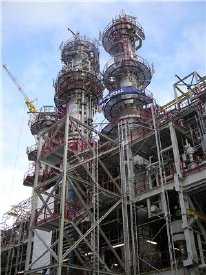Jan 17 2011
Industry separates crude oil, natural gas and chemical mixtures into pure products by means of fractionating distillation columns. This process is energy-intensive, but a new type of column structure promises energy savings of as much as 20 - 40 percent.
The petroleum industry relies on fractional distillation of raw materials to separate out products such as petrol, diesel oil and paraffin from crude oil, and methane, ethane and propane, etc., from natural gas. Process industry uses distillation to separate a wide range of mixtures of chemicals from which individual components or groups of components need to be extracted. Fractional distillation is also used by the pharmaceutical and food industries. Distillation towers are usually the tallest and most highly visible features in photos of refineries and process plants.
 Fractionating distillation columns separate out the heavier components of natural gas from the Snøhvit field, Norway.(Photo: SINTEF).
Fractionating distillation columns separate out the heavier components of natural gas from the Snøhvit field, Norway.(Photo: SINTEF).
Faster to the goal
Today, separation processes use a series of columns, each of which has its own reboiler and condenser. Each column produces two products or intermediate products.
Now, the trend is in the direction of a new type of energy-saving integrated column, which allow two or three traditional columns to be replaced by a single one fitted internally with vertical dividing walls. These are known as "Dividing Wall Columns", and enable more products to be separated using fewer reboilers and condensers and with a much lower energy consumption. It is also possible to reconfigure existing columns to make similar gains without having to rebuild their internal architecture.
In the fractionating columns in use today, losses occur when intermediate products flow from one column to the next: the separated fluids tend to mix again before the process continues to separate them again.
"We might compare this with going hill-walking, when the goal is a mountain-peak that we can see on the horizon. But to get there, we have to pass a number of smaller peaks, with descents into valleys that discourage us ahead of every new climb. The new column resembles a sort of bridge between the peaks; we no longer have to descend into the valleys," says Ivar Halvorsen of SINTEF ICT.
In 2001, Halvorsen took his doctorate on energy-efficient separation columns, in which he collaborated closely with Professor Sigurd Skogestad's group at NTNU. Since then, he has been working on problems of control and other challenges presented by the new integrated columns.
"Precise control is more important than it used to be, because the new configuration is more highly integrated. Any changes in conditions that we make in one column have to be compensated for somewhere else, but in practice, current technology allows us to do this," says Halvorsen.
Several advantages
Halvorsen believes that the new columns should be regarded as pure environmental technology. "Not only do we save energy in the process, but since that energy (heat) come from waste incinerators, there is a corresponding rate of savings in CO2 emissions. He mentions a separation system at Statoil's gas-processing plant at Kårstø, near Stavanger, which operates with as many as one hundred stages, and where integrating the separation columns more closely by reconnecting them could result in major energy savings.
"A third plus factor is that when we reduce energy consumption, the internal flow of steam from the boiler is also reduced, which enables us to physically slim down the columns themselves. When we add this to the need for fewer steam reboilers and condensers, it means that the capital cost of such columns is actually lower than those of traditional solutions. What usually happens is that the task of lowering energy consumption involves new costs because of the need to invest in new equipment; for example, when we have to increase the area of a heat exchanger in order to achieve more efficient energy transfer."
Up and running
The new type of column is already in operation on a number of sites. BASF, the huge German chemical group, is running more than one hundred of them. There, research scientist Gerd Kaibel has been the driving force behind the construction of columns with internal separation walls since the 1980s and 90s. These columns combine the functions of several traditional columns into a single unit, and BASF has found that the company can save money with this technology because it reduces both energy consumption and capital costs, and has made such columns part of its standard equipment because they give it a competitive advantage.
"But nothing is happening in Norway," says Halvorsen. Everyone is sitting on the fence, waiting. In the 90s, there was a lot of uncertainty regarding design and control, but the situation is different today. We have so much experience from BASF that we are no longer coming across any surprises, and both the US and Japan are adopting this technology. But Europe, represented by Germany and BASF, was there first, and we don't need to wait for anyone else."
As Halvorsen put it, this is not a matter of landing on the Moon, nor even of touching down at an airport where we have never been before. We still need to navigate a bit, but our course is reasonably certain and the trip would not cost billions of kroner. In fact, it would pay off right away.
"The challenge is to get the message across that this technology is avalable now, so that these new energy-saving solutions can be adopted now instead of employing the same solutions as in earlier projects," says Halvorsen.